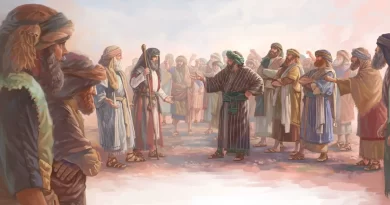The story of ruth and the law of kinsman salvation – रूथ और स्वजन उद्धार का नियम की कहानी
The story of Ruth and the law of the Kinsman Redeemer is a powerful example of loyalty, faith, and redemption in the Old Testament, found in the Book of Ruth.
In ancient Israel, the “Kinsman Redeemer” (or goel) was a male relative who had the responsibility to help a family member in distress. This concept is central in Israelite law and tradition, serving several purposes. If a family member sold their land due to poverty, the Kinsman Redeemer was responsible for buying it back to keep the property within the family (Leviticus 25:25). In cases where a man died without children, his brother or closest male relative was to marry the widow. This was known as levirate marriage (Deuteronomy 25:5-10). The first son from this union would be considered the heir of the deceased man, ensuring his family line continued. The Kinsman Redeemer could also serve as a protector of family members and their legacy, ensuring justice or care for widows and orphans.
Ruth was a Moabite woman, married to an Israelite man, Mahlon. After Mahlon, his brother Chilion, and their father Elimelech died, Naomi (Ruth’s mother-in-law) was left destitute in Moab. Naomi decided to return to Bethlehem, and Ruth chose to stay with her, pledging her loyalty and adopting Naomi’s people and God as her own (Ruth 1:16-17).
When they arrived in Bethlehem, Ruth went to glean in the fields to provide for herself and Naomi. Gleaning was an act of gathering leftover crops that the harvesters had missed, a practice allowed for the poor and foreigners (Leviticus 19:9-10). She happened to glean in the field of Boaz, a wealthy and honorable man who was related to Naomi’s late husband, Elimelech.
Boaz noticed Ruth and was impressed by her loyalty to Naomi. He instructed his workers to protect her and leave extra grain for her to gather. Boaz was kind to Ruth and went above and beyond to ensure she and Naomi were well-provided for.
Naomi realized Boaz was a close relative, potentially able to serve as a Kinsman Redeemer. She instructed Ruth to approach Boaz and ask him to fulfill this role, which included redeeming Elimelech’s land and marrying Ruth to provide an heir for the family line.
Ruth approached Boaz at night, lying at his feet as a sign of submission and petition for his protection (Ruth 3:7-9). She asked Boaz to “spread his garment over her,” symbolizing a request for marriage and protection under the Kinsman Redeemer law.
Boaz was willing to redeem Ruth and Naomi, but he knew there was a closer relative with a stronger claim. Boaz, showing respect for the law, sought out this man. When the closer relative declined due to the potential complications in his own inheritance, Boaz took up the responsibility himself.
Boaz redeemed Elimelech’s property, married Ruth, and they had a son, Obed. Through this act, Ruth was integrated into the people of Israel, and Naomi’s family line was restored. The story of Ruth and Boaz is especially significant because Obed became the grandfather of King David, establishing the royal line that would eventually lead to Jesus, fulfilling God’s promise of redemption.
he story of Ruth and Boaz beautifully foreshadows the concept of redemption through Christ. Like Boaz, who willingly took on the responsibility of redeeming Ruth and Naomi despite the cost, Jesus serves as our Redeemer, restoring and blessing us even when we were “foreigners” to the covenant.
Ruth’s story illustrates loyalty, providence, and God’s redeeming love—through her life, God brought about a lineage that would bless generations.
The story of ruth and the law of kinsman salvation – रूथ और स्वजन उद्धार का नियम की कहानी



